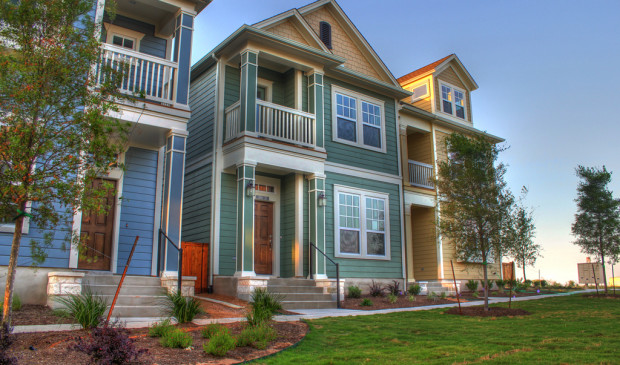Mueller neighborhood seeks more density
Monday, January 25, 2016 by
Jo Clifton Members of the Mueller Neighborhood Association say the city and developer Catellus Development Corp. should increase density in the development in order to help ameliorate the city’s housing problems. They are asking that the city remove existing density caps and revise the Mueller Planned Unit Development with higher building heights and a greater number of dwelling units.
Catellus currently plans to build more than 6,000 units, according to company spokeswoman Dee Desjardin. A resolution passed by the neighborhood association notes that the maximum number of dwelling units is capped at 6,450 under the current traffic impact analysis. That traffic projection seems to be the major obstacle to adding more density.
The resolution notes that Mayor Steve Adler “has recently called for 100,000 new housing units to be built by 2025; and … to realize the mayor’s goal while meeting the dictates of Imagine Austin and grow as a compact and connected city it will mean finding areas in central Austin that can best accommodate growth.”
David Neider, chair of the neighborhood group, said, “Affordability, economic segregation and traffic congestion all can be addressed by increasing the number of people per square mile, and this resolution directly addresses Mayor Adler’s objective of adding 100,000 housing units to the city core.”
Not only does the neighborhood association urge Catellus to build to the density limit, but it calls for the city to work with Catellus and Capital Metro “to connect Mueller to transit sufficiently to allow the density caps limited by any traffic impact analysis to be lifted.”
Desjardin noted that it is highly unusual for a neighborhood group to come out in support of more density.
“It’s great; it’s really encouraging to hear that the residents in Mueller are in support of density and that they think the plan for Mueller is working well,” said Desjardin. “We, of course, think that the master plan here and the approach to density has really been successful, and so we are always looking at those future opportunities. … We are always in the process of evaluating our progress and our density.”
A press release from the neighborhood group says, “About 50 percent complete, the master-planned mixed-use Mueller Community on the 700-acre site of Austin’s former Robert Mueller Municipal Airport was designed for 6,450 dwelling units, 13,000 residents and employment of 13,000. It is home to several large employers, retailers, restaurants, popular parks and lakes. The MNA resolution supports increasing the ultimate population while preserving the green space and other amenities, existing or envisioned.”
Adler told the Austin Monitor via email: “The Mueller master plan was a collaborative effort that included the surrounding neighborhoods. We would want to ask their opinions about this idea before making any changes to something that took a lot of people a long time to come up with. That said, without knowing the details of this proposal, often increased density can lead to more affordability by giving people more choices.”
Mayor Pro Tem Kathie Tovo, whose district includes Mueller, said, “When the Mueller PUD was set up, the PUD was set up … with the streets and other infrastructure in such a way that it supports that level of density. However, it’s contingent upon having a level of public transportation” that Mueller does not currently have.
Tovo added, “They do not currently have the transportation option that would allow them to build to those higher levels of density.” She said that increasing public transportation would have to be part of the conversation in order to allow higher levels of density at the development.
If Mueller were connected via high-capacity transit, it could automatically bump up the allowable density, said Mateo Barnstone, a member of the neighborhood association’s steering committee. Barnstone said he hoped that city planners would pay attention to the resolution now because Mueller is currently only 50 percent developed. Later on, it will be more difficult to change the plans and increase the density.
Barnstone added, “This is a vote of confidence in the developer and the plan and the city, and we think we could take on a little bit more. And we think areas like the early retail area could be redeveloped as mixed-use areas – take some underperforming asphalt and make it into an attractive area of town.”
The Mueller Neighborhood Association has sent its resolution to the city’s Robert Mueller advisory commission, which makes recommendations concerning the area’s redevelopment, and asked that the item be put on the next agenda.
Photo by Garreth Wilcock made available through a Creative Commons license.
You're a community leader
And we’re honored you look to us for serious, in-depth news. You know a strong community needs local and dedicated watchdog reporting. We’re here for you and that won’t change. Now will you take the powerful next step and support our nonprofit news organization?










